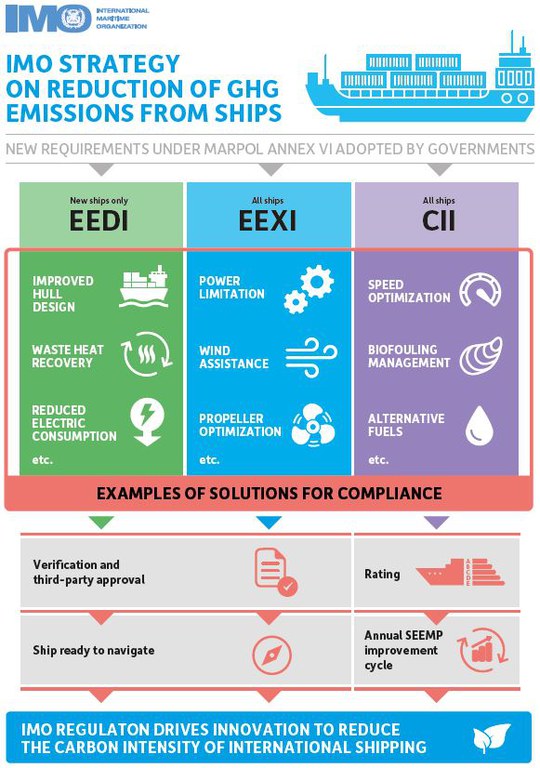BG Verkehr / Dienststelle Schiffssicherheit
Referat Maschine
Brandstwiete 1
20457 Hamburg

Holger Steinbock
Phone: +49 40 36137-217
Fax: +49 40 36137-204
Mail: maschine@bg-verkehr.de

Jörg Heuckeroth
Phone: +49 40 36137-231
Fax: +49 40 36137-204
Mobile: +49 171 50 57 038
Mail: maschine@bg-verkehr.de
Bundesamt für Seeschifffahrt und Hydrographie
Referat S15 - Umweltschutz im Seeverkehr
Bernhard-Nocht-Straße 78
20359 Hamburg

Katrin Ewert
Phone: +49 40 3190-71500
Fax: +49 40 3190-5000
Mail: marpol@bsh.de
Energy Efficiency
- Energy Efficiency Index
- Ship Energy Efficiency Management Plan (SEEMP)
- Collection of fuel consumption data
- Rating the Carbon Intensity Indicator (CII)
- International Energy Efficiency (IEE) certificate
Energy Efficiency Index
Harmful ship exhausts can not only be reduced by using higher-grade and low-carbon fuel or scrubbers but also by increasing a ship's energy efficiency. According to Annex VI of the MARPOL Convention, every ship on international voyages is required to have an energy efficiency index – namely:
- An existing ship receives an Energy Efficiency Existing Ship Index (EEXI), and
- a new ship receives an Energy Efficiency Design Index (EEDI).
These indexes, EEDI and EEXI, indicate the CO2 emissions per ton of cargo and nautical mile sailed for a sea-going vessel. The energy efficiency of tankers, bulk carriers and container ships can be calculated by a formula taking into account the ship’s size. There are also formulas for other types of ships such as ferries, passenger ships or special types of ships (e.g. tugs and supply vessels).
The data and performance curves of the individual ship required for the calculation of the EEDI and EEXI as well as the calculation procedure are recorded in the EEXI Technical File for existing ships and the EEDI Technical File for new ships.
In addition, a reference line is established for every ship type. The EEDI/EEXI of the given ship may not exceed this reference line. This reference line will be re-adjusted to the technical advances in ship technology at fixed intervals (four phases).
The aim of the energy efficiency index is a reliable and transparent basis for a comparison to promote the development of more efficient ships and at the same time specify a minimum efficiency based on the type and size of ship.
Find out more about EEDI and the EEXI in the following resolutions by the International Maritime Organization, IMO:
- resolution MEPC.365(79) – 2022 Guidelines on survey and certification of the Energy Efficiency Design Index (EEDI)
- resolution MEPC.364(79) - 2022 Guidelines on the method of calculation of the attained Energy Efficiency Design Index (EEDI) for new ships
- resolution MEPC.231(65) – 2013 Guidelines for calculation of reference lines for use with the Energy Efficiency Design Index (EEDI)
- resolution MEPC.233(65) – 2013 Guidelines for calculation of reference lines for use with the Energy Efficiency Design Index (EEDI) for cruise passenger ships having non-conventional propulsion
- resolution MEPC.350(78) – 2022 Guidelines on the method of calculation of the attained Energy Efficiency Existing Ship Index (EEXI)
- resolution MEPC.351(78) – 2022 Guidelines on the survey and certification of the Energy Efficiency Existing Ship Index (EEXI)

Ship Energy Efficiency Management Plan (SEEMP)
Another measure to increase energy efficiency on board of ships is the Ship Energy Efficiency Management Plan (SEEMP). The shipowner of existing ships (not only new ships) is required to develop such a management plan on the basis of the IMO guidelines and to keep it permanently on board. This plan should reflect all parameters influencing fuel consumption during operation. The SEEMP consist of three parts:
- Part I – Ship-specific management plan to improve energy efficiency and reduce carbon intensity of a sea-going ship of 400 GT and more on international voyages. This plan may be part of the ship's safety management system and contains planning, implementing, monitoring as well as evaluation and improvement measures. One aspect of this is the utilization of shore power in ports whenever and wherever it is offered and ships can use it.
- Part II – Ship fuel oil consumption data collection plan for sea-going ships of 5,000 GT and more on international voyages: Development of a ship-specific method to collect, aggregate and report ship data on the annual fuel oil consumption.
- Part III – Ship operational carbon intensity plan for sea-going ships of 5,000 GT and more on international voyages: Calculation and comparison of the attained and the required annual operational CII, implementation plan for the next three years, self-evaluation and improvement and corrective measures.
The IMO has published 2022 Guidelines for the development of a Ship Energy Efficiency Management Plan (SEEMP) (resolution MEPC.346(78)) which detail these three parts of the plan.
Collection of fuel consumption data
The Data Collection System (DCS) for the fuel oil consumption of ships of the IMO for ships on international voyages from 5,000 GT is implemented in Part II of the SEEMP (ship energy efficiency management plan):
a) Once:
The shipowner submits the updated SEEMP of his/her German-flagged ships to a recognized organization (RO) for verification. It contains the ship-specific method to collect, aggregate and report ship data about the annual fuel oil consumption.
The data collection can be done by:
- Collection of fuel oil taken by the bunker delivery notes (BDN)
- use of flow meters
- tank monitoring or
- direct CO2 exhaust gas measurement
The RO transmits its survey report or the confirmation of compliance for the ship fuel oil consumption data collection plan to the Ship Safety Division (Dienststelle Schiffssicherheit) of the BG Verkehr for approval, which in turn will issue the appropriate certificate.
b) Annually:
The shipping company transmits the data collected throughout the year to the Ship Safety Division until the 1st April the following year.
Which data is required to be submitted is indicated in Appendix 3 of resolution MEPC.346(78) as well as Appendices 1 and 2 of resolution MEPC.348(78).
The annual data of the consumption of fuel oil are entered into the IMO Fuel Oil Consumption Database. This procedure includes that the Ship Safety Division issues a statement of compliance about the fuel oil consumption reporting to the IMO for each ship flying the German flag.
In addition to the Data Collection System (DCS) of the IMO, shipping companies also have to report the fuel oil consumption data of their sea-going vessels to the German Emission Trading Authority (DEHSt) in accordance with EU law, based on the maritime transport regulation EU MRV ((EU) 2015/757). Therefore, this procedure is not part of the competency of the Ship Safety Division.
We have compiled a more detailed comparison of the two reporting programmes (IMO / EU) for you.
Rating the Carbon Intensity Indicator (CII)
The Marine Environment Protection Committee, MEPC, of the IMO has agreed on further measures to further reduce the fuel consumption of the world's merchant fleet and thereby its CO2 emissions. According to these measures, a sea-going ship's operation has to be aligned with strict CO2 emission values. In order to do this, every sea-going ship receives an evaluation of its CO2 intensity, which is split in five ratings from A to E. This rating is based on the Carbon Intensity Indicator, CII.
Based on the CII, shipping companies have to develop a binding catalogue of corrective actions if a ship is rated E or for three consecutive years rated D in order to save enough CO2 to return to rating C as a minimum. This rating is calculated on the basis of the data of the ship's carbon emission of the previous year and implemented in Part III of the SEEMP.
This instrument is supposed to increase the pressure on ship operators to only deploy their most efficient ships in the market. Furthermore, the CII creates transparency to all market participants and a comparable data basis.
Further information on the CII:
- resolution MEPC.352(78) – CII Guidelines, G1
- resolution MEPC.353(78) – Guidelines on CII reference lines, G2
- resolution MEPC.338(76) – Guidelines on CII reduction factors, G3
- resolution MEPC.354(78) – Guidelines on CII ratings, G4
- resolution MEPC.355(78) – CII Guidelines on correction factors and voyage adjustments, G5
International Energy Efficiency (IEE) certificate
The flag state confirms with the International Energy Efficiency Certificate (IEE certificate) that there is
- a Ship Energy Efficiency Management Plan (SEEMP) as well as
- an EEDI (only new ships from 1 July 2013)
in place. The IEE certificate is mandatory for any ship on international voyages with a size of 400 GT and above.
The Ship Safety Division of the BG Verkehr issues the certificate for ships under German flag on the basis of a survey by a class.
Ships have to become more efficient
IMO's Maritime Environment Protection Committee MEPC adopted several measures to further reduce the world's merchant fleet's fuel consumption and thereby its CO2 emissions. For the first time, these provisions include existing ships as well.
With two measures MEPC wants to make sea-going ships more efficient, and therefore more environmentally friendly:
- All ships of 5000 GT and more have to meet certain efficiency standards with the new EEXI (Energy Efficiency Existing Ship Index). In order to achieve this, ship operators have to implement technical means to significantly lower their fuel consumption and thereby the CO2 emissions of their ships. Already since 2013, a similar requirement, the EEDI (Energy Efficiency Design Index), has been in place for existing ships. The EEXI engages nearly the complete trading global merchant fleet to reduce their current CO2 emissions by up to 50 % depending on the ship type from 2023.
- Moreover, the IMO requires that from 2023 the ship operations are aligned with stricter CO2 emission levels. Every ship receives an assessment of its CO2 intensity, which is divided into five categories from A to E. This categorization is done with the CII (Carbon Intensity Indicator). A similar assessment is already known from electronic devices and cars. Based on the Carbon Intensity Indicator CII, shipping companies whose ships are assessed as class D or E in three in consecutive years have to develop a list of measures to reduce CO2 sufficient to return to class C. This instrument is also meant to increase pressure on ship operators to deploy only their most efficient ships on the market. In addition, the CII creates transparency for all market participants and a comparable data pool.
Currently, international working groups develop guidelines for the implementation of these measures to ensure the starting date 1st January 2023. Furthermore, the IMO panels plan further measures to reduce emissions from shipping such as alternative fuels, emission trade, as well as a CO2-free maritime transport of goods in the long run. The MEPC has not made any concrete decisions to this regard, however.

